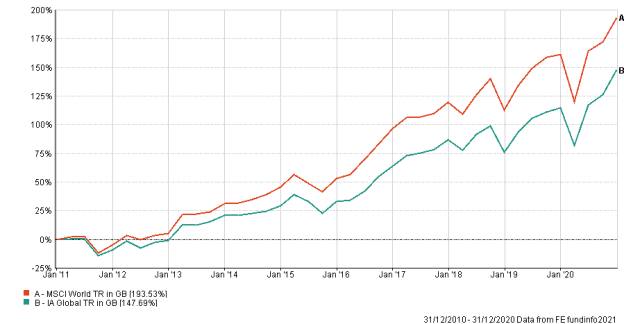
The market conditions which generally prevailed in the decade from the end of the financial crisis to the start of the global pandemic were ideally suited to passive investing.
Central banks' policy of buying bonds as part of quantitative easing programmes pushed bond prices upwards, and kept interest rates low. This also benefited equities generally as it meant the rewards for owning bonds were lessened.
In such a climate, a multi-asset portfolio containing mainstream bonds and the equities of most markets did well, with exposure to those assets from passive instruments delivering returns.
The onset of the pandemic led to a sharp bifurcation in asset price performance, with those stocks perceived to be losing out as a result of the changes wrought by the pandemic falling sharply, while those perceived to be benefiting rose sharply.
As vaccines rolled out, market participants became more optimistic about the economy, and, at the start of February, began to buy many of the economically sensitive stocks that had fallen farthest, and sell off many of the technology-focused stocks that had performed best.
Such a volatile climate contrasts with the benign market conditions of the previous decade, and may prove a challenge for passive investment returns, says Kevin Thozet, member of the investment committee at Carmignac.
He says bond investors will find that in the changed economic climate there is an increased chance that some companies will default on their bonds, while some companies which had been reliable income payers pre-pandemic, are structurally challenged and may never return to previous payment levels, which will have long-term consequences for the place of those stocks in passive income portfolios.
Nick Watson, multi-asset investor at Janus Henderson, says that historically periods of volatility in investment markets are when active funds tend to outperform passive.

Sunil Krishnan, multi-asset fund manager at Aviva Investors, says a feature of the economy during the pandemic has been that many smaller companies have performed well. He says advances in technology also make it easier for smaller companies to grow quickly.
Krishnan says in such an environment, passive funds which buy the companies in an index based on their size, may struggle as those businesses lose out to smaller companies that are further down the index.
He says: “Disruption is the friend of the active investor, and so we are more interested in active investing now than we were last year, we are now leaning on the active managers more for solutions now.”
Keith Balmer, multi-asset fund investor at BMO Global Asset Management uses both active and passive strategies in the mandates he runs, but says that an investor whose priority is income will likely need exposure to active funds to achieve the target, particularly as to achieve a decent yield right now may require allocating to emerging market bonds and high yield bonds, both areas where he believes passive investing would struggle to beat active.








